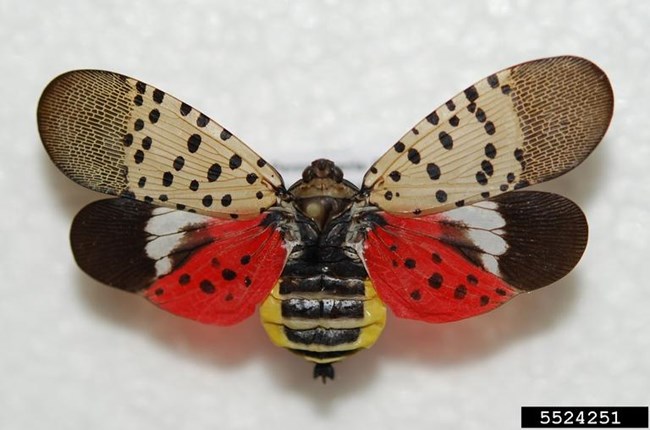Last updated: August 19, 2024
Article
Spotted Lanternfly 101

Lawrence Barringer, Pennsylvania Department of Agriculture, Bugwood.org
[This article was written in 2019. A follow-up article, "Spotted Lanternfly in Perspective" was published in 2020. As of January 2024, spotted lanternfly (SLF) has been documented throughout the National Capital Region (NCR) and beyond and it is no longer necessary to report SLF sightings.]
by Dorothy Borowy, Integrated Pest Management Coordinator for the National Capital Area
Spotted lanternfly is a new, invasive, insect pest approaching the National Capital Area (NCA). Here’s what you need to know.
What is it and what does it do?
Spotted lanternfly (SLF; Lycorma delicatula) is an invasive insect native to China, India, and Vietnam. It was first identified in the U.S. in 2014, in Berks County, Pennsylvania. Despite its name, spotted lanternfly is not a fly; it is a planthopper in the order Hemiptera, which also includes true bugs, aphids, and cicadas. It spreads primarily by hopping (in the juvenile stage) and short-distance flight (in the adult stage)--similar to its close relative, grasshoppers. As a result, SLF does not typically move very far without help. Unfortunately, human action is currently the main factor helping spread SLF in the U.S.
People can unknowingly move the inconspicuous egg masses over long distances when moving plants (e.g. nursery trade), firewood, construction and shipping materials (e.g. stone, lumber, wood crates), outdoor household articles (e.g. grills, mowers, furniture) or recreational vehicles. So it’s vital that anyone visiting or traveling through a quarantined area is aware of the risks of spreading SLF, and take extra precautions.
Once established in an area, SLF has the potential to dramatically affect forest ecosystems, agricultural production, and cultural resources. Although SLF has a preference for feeding on the exotic tree-of-heaven (Ailanthus altissima), it is an indiscriminate pest and will feed on over 70 different plant species. It impacts its host directly by extracting plant sap from young leaves and stems using piercing and sucking mouthparts, and causes indirect harm by excreting a sugary liquid (honeydew) that attracts other insects and promotes the proliferation of black sooty mold, which can negatively affect plant growth and initiate secondary fungal infections.
How close is it?
To date, Spotted Lanternfly (SLF; Lycorma delicatula) has not been observed in any National Capital Area (NCA) parks. However, there have been several confirmed sightings nearby resulting in quarantines for counties throughout Pennsylvania, Delaware, northern Virginia, New Jersey, and Maryland. Of particular concern are the quarantined areas in Virginia (Frederick County and the City of Winchester) and Maryland (Harford and Cecil counties) as they are within 50 miles of five NCA parks: Catoctin Mountain Park, Antietam National Battlefield, Harpers Ferry National Memorial Park, and the Chesapeake & Ohio Canal National Historical Park.

New York State Integrated Pest Management Program
What are NCA parks doing?
Most SLF work in NCA so far has focused on education and preventing the introduction of the pest into the area’s parks. In addition, the Invasive Plant Management Team (formerly the Exotic Plant Management Team or EPMT) has been selectively treating the exotic clusters of tree-of-heaven (Ailanthus altissima)—a preferred host species for SLF—in parks closest to quarantined areas to help limit SLF introduction pathways.
What training is available?
Although SLF has not been observed in any NCA parks, all NPS employees are encouraged to learn about SLF and its management through training and online resources including those listed below. (List is not exhaustive.)
A comprehensive training guide—focused on SLF identification and behavior, how to safely destroy SLF, and how to implement best practices in areas with SLF--is available through Penn State Extension (first in the list). The training is free and is required for all businesses that operate in quarantine zones, but it is available to anyone who is interested.
Penn State Extension: free permit training
Penn State Extension: Spotted Lanternfly
U.S. Department of Agriculture-National Invasive Species Information Center: Spotted Lanternfly
U.S. Department of Agriculture-Forest Service: Spotted Lanternfly
Pennsylvania Department of Agriculture: Spotted Lanternfly
Delaware Department of Agriculture: Spotted Lanternfly
Maryland Department of Agriculture: Spotted Lanternfly
Virginia Department of Agriculture and Consumer Services: Spotted Lanternfly
University of Maryland Extension: Spotted Lanternfly
Urban & Community Delaware Forest Service: Spotted Lanternfly in Delaware
The Nature Conservancy-Don’t Move Firewood Campaign
Tags
- anacostia park
- antietam national battlefield
- baltimore-washington parkway
- catoctin mountain park
- chesapeake & ohio canal national historical park
- fort dupont park
- fort foote park
- fort washington park
- glen echo park
- great falls park
- greenbelt park
- harpers ferry national historical park
- kenilworth park & aquatic gardens
- manassas national battlefield park
- monocacy national battlefield
- national capital parks-east
- national mall and memorial parks
- piscataway park
- prince william forest park
- rock creek park
- wolf trap national park for the performing arts
- ncrn
- natural resource quarterly
- winter 2019
- national capital region
- ipm
- invasive species
- insect
- pests
- nature
- ncr
- integrated pest management
- forest pests
